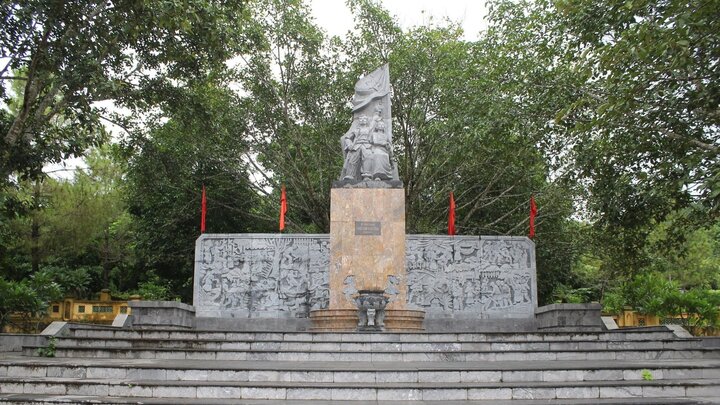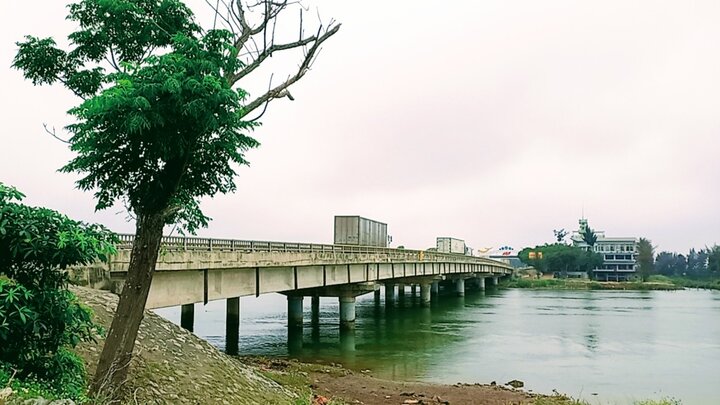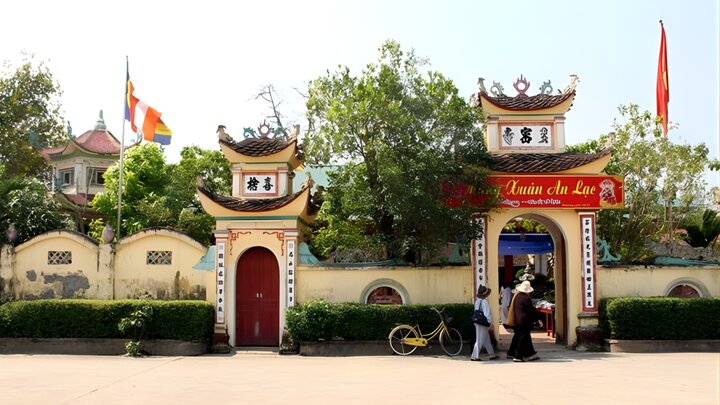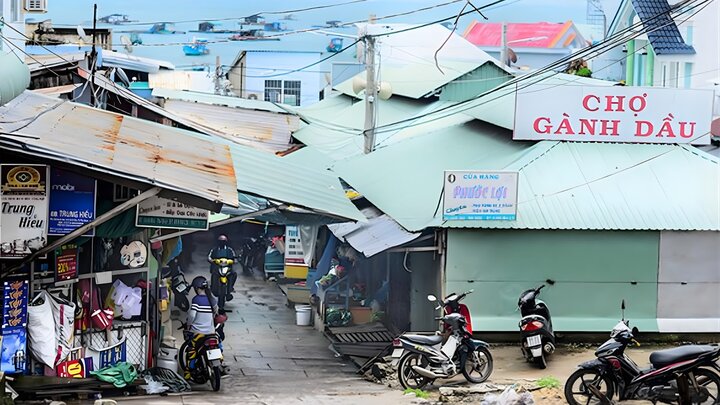1. Overview of Trieu Tuong Temple and Mausoleum
1.1 Origin and Location of the Temple and Mausoleum
When the first steps were taken in the territorial expansion journey of Lord Tien Nguyen Hoang, the foundation for the Nguyen dynasty was laid. The Trieu Tuong Temple and Mausoleum complex is located in Gia Mieu village, Ha Long commune, which is the sacred origin of this lineage. In the past, this land belonged to Thuong Ban commune, Tong Son district, Ha Trung province, Thanh Hoa region. This place is considered the origin of the Nguyen family. Later, it became the resting place of Emperor Trieu To Tinh Nguyen Kim, the father of Nguyen Hoang, who contributed to expanding the territory southward.

The scenery outside Trieu Truong Temple. (Source: Collected)
According to documents, many villages in Nghe An, Ha Tinh, and the Central Central region today were founded by people from Thanh Hoa who followed Nguyen Hoang in 1558. Most of them were officials, soldiers, and villagers from Tong Son (Ha Trung), who carried with them a spirit of diligence, loyalty, and patriotism. Therefore, the title “people of Tong Son” became a symbol of honor, expressing pride in the origin of the Nguyen family.
1.2 The birth of the Trieu Truong Temple and Mausoleum complex
From that sacred meaning, immediately after ascending the throne in 1802, King Gia Long ordered the construction of the Trieu Truong Temple and Mausoleum complex in Gia Mieu village, the ancestral home of the Nguyen family. The King personally traveled to pay homage to the Thien Ton Mausoleum and honored this land as Quy Huong. At the same time, he posthumously honored Nguyen Kim as Trieu To Tinh Hoang De, named the mausoleum Truong Nguyen, and built Nguyen Mieu to worship the former kings.

Materials about Trieu Truong mausoleum taken by the French. (Source: Collected)
During the reign of King Minh Mang, Thien Ton mountain was renamed Trieu Tuong mountain, and the mausoleum complex was also renamed Trieu Tuong mausoleum . This complex is not only a place to honor and worship the ancestors of the Nguyen royal family, but also a symbol of the moral principle “when drinking water, remember the source”, expressing the deep gratitude of the Nguyen kings towards the merits of their predecessors who built a glorious dynasty that lasted for over 140 years in the nation's history.
2. How to get there and experience the journey
The journey to the Trieu Tuong mausoleum complex is quite convenient. Visitors only need to travel along National Highway 1A northwards for about 35 km to reach the area of Ha Trung commune, then turn into Gia Mieu village, where the relic site is located. The road is flat, traffic is smooth, very suitable for cars, motorbikes, or tourist vehicles, making the trip easy and comfortable.
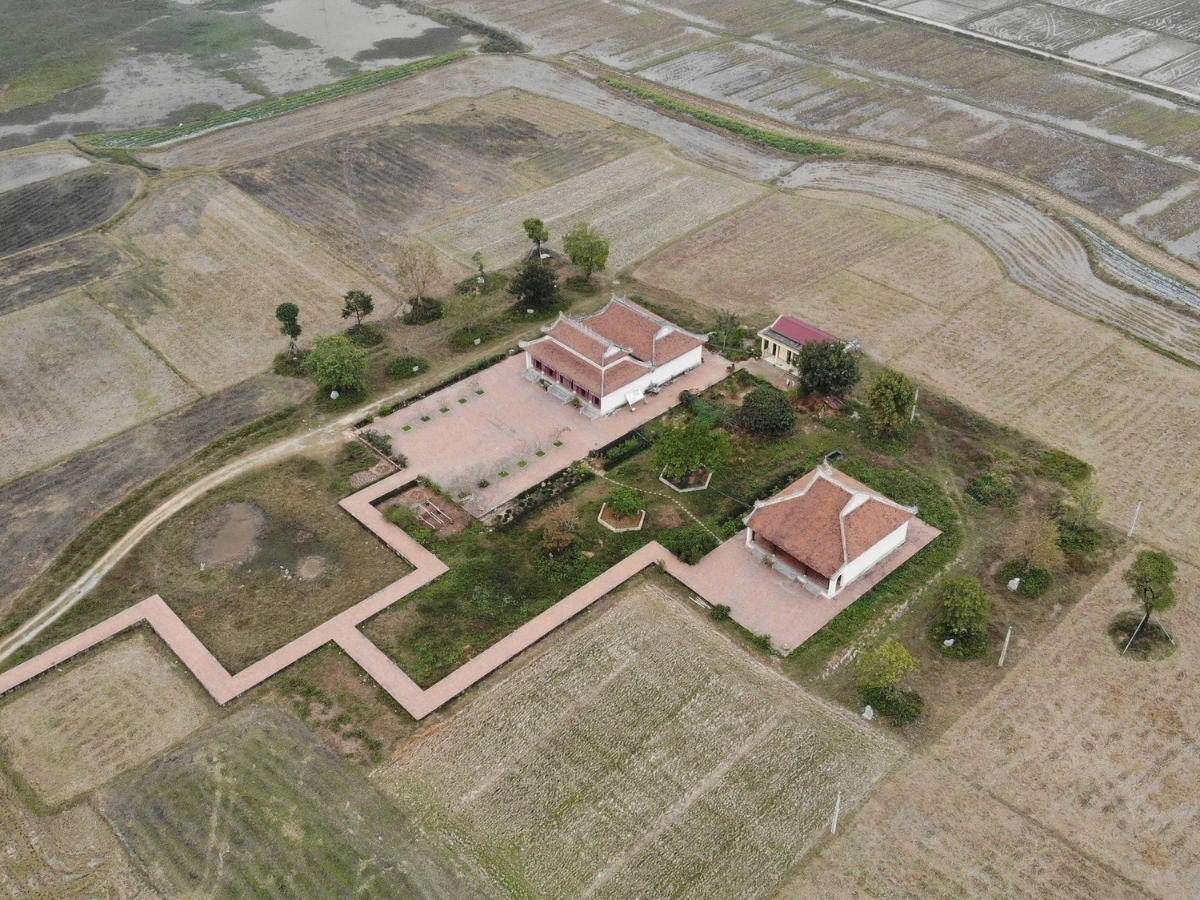
Overview of the area around the Trieu Truong Temple and Mausoleum. (Source: Collected)
Upon arrival, visitors will find a spacious parking area located near the entrance to the relic. From here, a stone-paved path leads to the temple and mausoleum, winding under lush green trees, creating a sense of purity and relaxation. This short walk not only offers an opportunity to breathe in the fresh air but also a slow journey to fully appreciate the sacredness and solemnity of this "noble land".
3. Ideal Time to Explore
Visitors can visit the Trieu Truong Temple and Mausoleum at any time of the year, as it always possesses a unique beauty, both ancient and peaceful. Spring is when the scenery is most vibrant, with cool weather, lush greenery, and blooming flowers, creating a picturesque scene that enhances the sacred space of the relic.
During summer and early autumn, the area around the foot of Trieu Truong mountain offers a sense of tranquility and grace with birdsong and the gentle breeze from the Ma River. Regardless of when you visit, the journey to explore the Trieu Truong Temple and Mausoleum provides visitors with an opportunity to admire the harmonious beauty between nature and heritage, a space preserving the roots of the Nguyen dynasty in the heart of Thanh land.
4. Notable Experiences at Trieu Truong Temple and Mausoleum
4.1 Architecture and Historical Relics
The Trieu Truong Temple and Mausoleum was built on a large scale, consisting of two main areas: Truong Nguyen Mausoleum, which is the burial place of Emperor Trieu To Tinh Nguyen Kim. And Trieu Truong Temple is where the ancestors of the Nguyen family are worshipped. The construction began in 1806 during the reign of King Gia Long, located in a field at the foot of Trieu Truong mountain, about 1 km from the mausoleum complex. According to ancient records, the temple was built with great effort and was likened to a "miniature Hue Citadel".
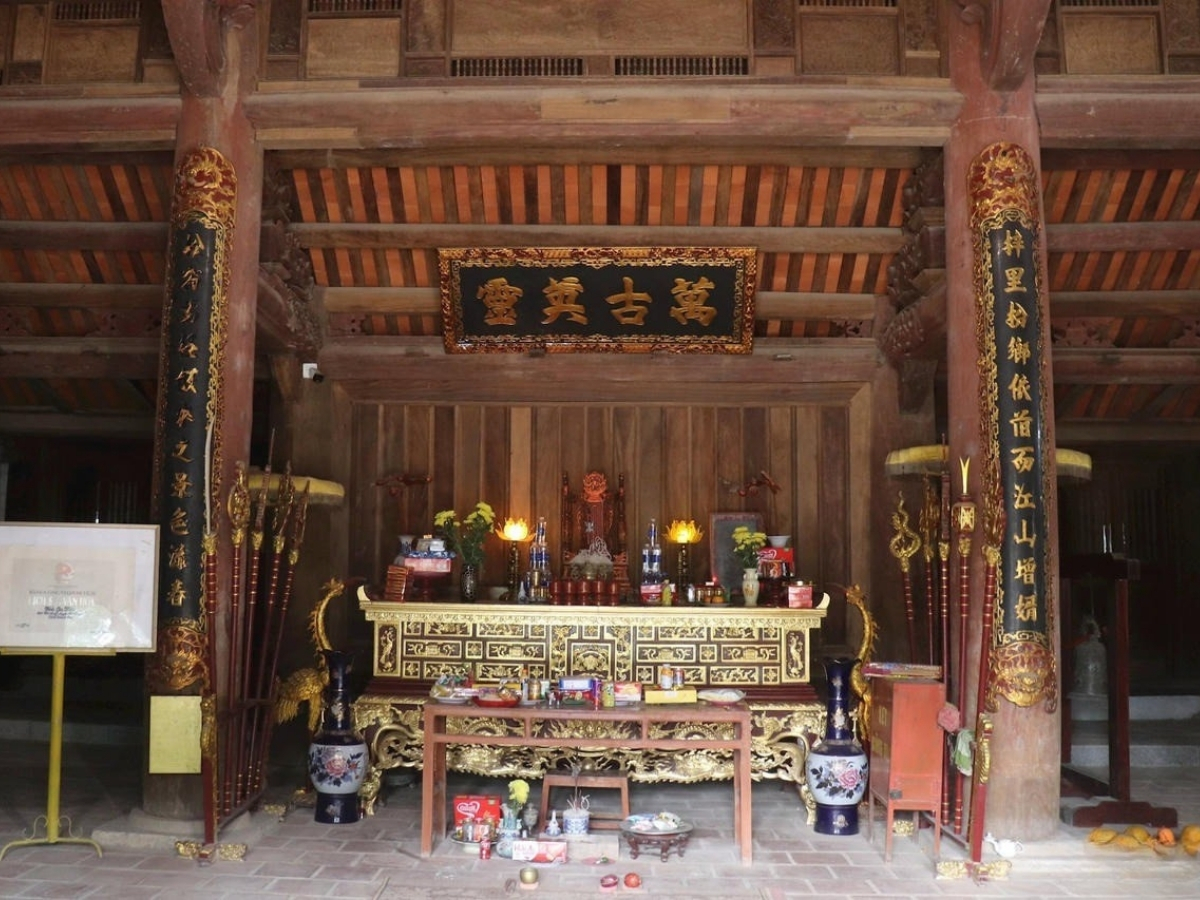
The scene inside Trieu Truong Mausoleum-Temple. (Source: Collected)
Trieu Tuong Temple comprises two major structures: Nguyen Mieu (the main temple), which worships Trieu To Tinh Emperor Nguyen Kim in the central chamber and Thai To Gia Du Emperor Nguyen Hoang in the left chamber; and Trung Quoc Cong Temple to the East, which is where Trung Quoc Cong Nguyen Van Luu (father of Nguyen Kim) and Nguyen Han (son of Nguyen Hoang) are worshipped. The entire architecture faces South, bearing the majestic and grand style characteristic of Nguyen Dynasty court architecture. The overall structure of the relic site follows the layout of “outer citadel - inner temple”. Specifically, outside is a surrounding citadel wall and moat, while inside is divided into various functional areas, with Nguyen Mieu as the center.

Truong Nguyen Mausoleum is located on Thien Ton mountain. (Source: Collected)
Through many archaeological excavation campaigns, especially in 2019 over an area of more than 4,000 m², researchers discovered diverse traces. These include city walls, nghi môn (gateways), stone bridges, crescent-shaped lakes, guest houses, warehouses, along with nearly 3,000 artifacts made of ceramics, pottery, and metal dating from the 16th to 20th centuries. These artifacts clearly reflect the construction level, exquisite decorative art, and the brilliant development of Dai Viet civilization under the Nguyen dynasty.
4.2 Historical value
Trieu Tuong Mausoleum and Temple holds special significance in affirming the origins of the Nguyen dynasty. This place is associated with Nguyen Kim, who laid the foundation for the restoration of the Le dynasty and paved the way for the emergence of the Nguyen dynasty. When he ascended the throne in 1802, King Gia Long had a temple built to commemorate his ancestors and posthumously honored Nguyen Kim as Trieu To Tinh Emperor, demonstrating the nation's principle of 'when drinking water, remember its source'.

Mausoleum dedicated to Lord Nguyễn Hoàng. (Source: Collected)
Many Nguyễn Dynasty kings such as Gia Long, Minh Mạng, Thiệu Trị, Thành Thái, and Khải Định have returned here to offer incense and pay respects to their ancestors, showing deep gratitude to their predecessors.
Today, the Triệu Tường Mausoleum is not only a sacred place of worship for the Nguyễn family but also a national-level archaeological site (recognized in 2007), preserving precious historical, cultural, and artistic values of Vietnam. It is a special destination for visitors to learn about the origin of the Nguyễn Dynasty and contemplate the spirit of filial piety and gratitude to ancestors.
5. Experience and Tips
Before visiting the Triệu Tường Mausoleum, visitors should note a few points:
Choose to wear discreet, polite, and modest clothing, avoiding short, tight, or overly colorful attire to maintain the solemnity of the site.
Maintain a gentle and respectful attitude, move slowly, speak softly, and do not laugh or talk loudly within the worship area.
Comply with the regulations of the site management board when taking photos or videos; only do so in permitted areas and do not touch artifacts or ancient structures.
Prepare simple offerings such as incense, fresh flowers, and betel and areca if you wish to offer sacrifices to remember ancestors; limit paper money or inappropriate offerings.
Take time to stroll, observe, and contemplate to feel the sacred atmosphere and learn more about the history of the Nguyễn Dynasty's formation.
Maintain general hygiene, do not litter, and protect the landscape and space of the site to contribute to preserving cultural values for future generations.
6. Combining Tourist Destinations in Thanh Hóa
6.1 Đồng Cổ Temple
Đồng Cổ Temple is a sacred stopover located in Yên Thọ commune, not far from the Triệu Tường Mausoleum. The temple worships God Đồng Cổ, a divine mountain god considered a symbol of loyalty and patriotism. The space here carries an ancient spiritual atmosphere with curved tiled roofs, an imposing triple-arched gate, and picturesque river and mountain scenery.

Dong Co Temple viewed from above. (Source: Collected)
Coming to Dong Co Temple, visitors can not only worship and offer incense but also have the opportunity to immerse themselves in the traditional festival held annually in the 3rd lunar month. Combining a visit to Dong Co Temple with the Trieu Tuong Mausoleum will bring a complete journey, where visitors can both contemplate historical values and feel the depth of the spiritual beliefs characteristic of the Thanh region.
6.2 Historical site Ba Trieu Temple
About 25 km south of the Trieu Tuong Mausoleum area, Ba Trieu Temple is where the national heroine Trieu Thi Trinh is worshipped. She led the uprising against the Ngo dynasty's rule in the 3rd century. Standing out amidst the Thanh Hoa mountains and forests, the majestic temple leans against Nui Gai mountain, facing the plains, symbolizing the indomitable spirit of the girl who "wants to ride the strong wind, trample the fierce waves". Annually, in the 2nd lunar month, the Ba Trieu Festival is held here. This is one of the largest traditional festivals in Thanh Hoa, attracting tens of thousands of visitors. Visiting Ba Trieu Temple helps to deepen the journey of exploring the land where the Nguyen dynasty originated, as we witness the harmony between the history of nation-building and the indomitable spirit of the people of the Thanh region.
6.3 Sam Son Beach
After exploring ancient historical sites, visitors can relax at Sam Son Beach - one of the most famous beaches in Central Vietnam. Sam Son Beach captivates with its fine sandy shore, clear blue waters, and year-round rolling waves. In the morning, visitors can watch the sunrise over the sea, stroll along the wave-side path, or enjoy fresh seafood at the beachfront restaurants.
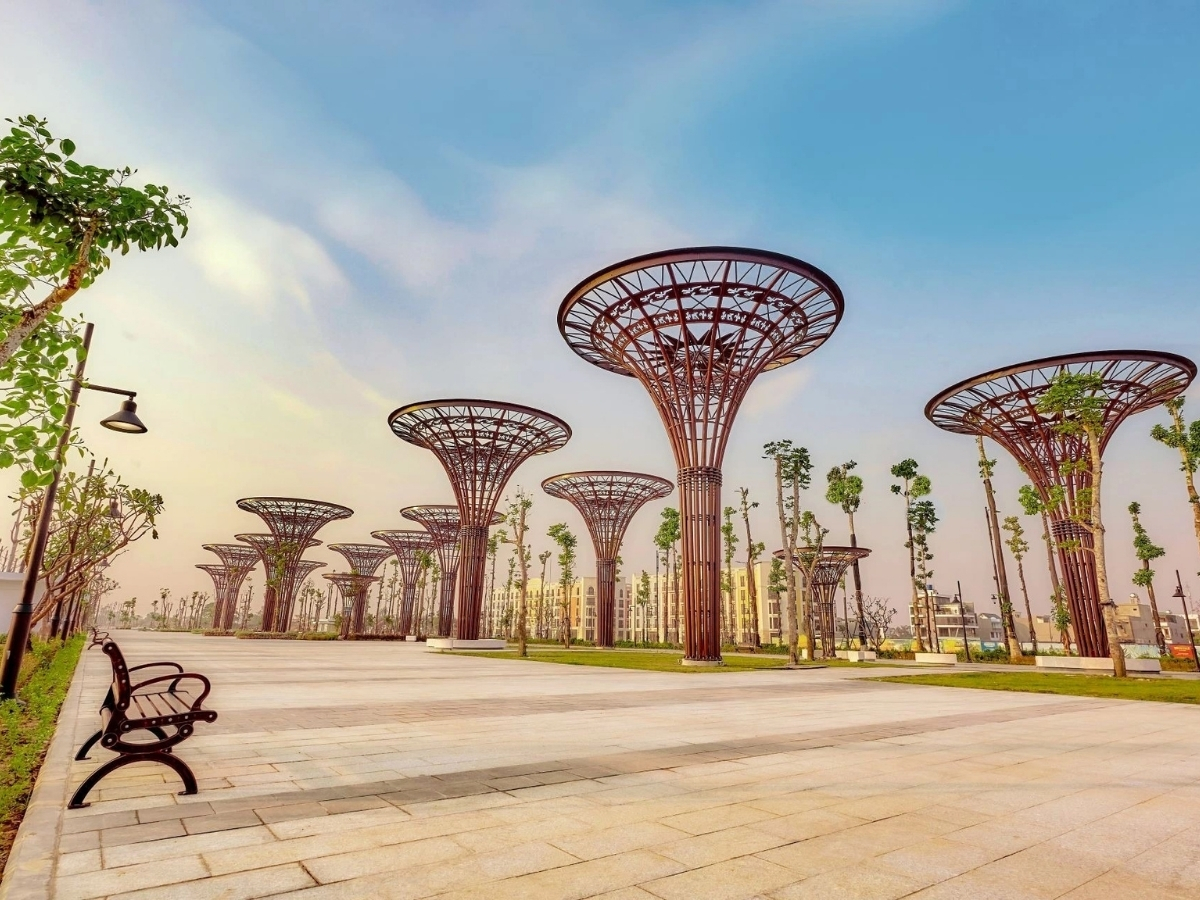
Sam Son Sea Square is a must-visit destination. (Source: Collected)
Especially, Sam Son Sea Square is an unmissable attractive check-in spot. With its vast space, modern landscape, combined with artistic lighting and a unique water music system, this place becomes the center for organizing major cultural and tourism events of the province. The combination of the majestic past of Trieu Tuong Temple Complex and the modern, vibrant Sầm Sơn offers visitors a journey to explore history - culture, and fully enjoy the beauty of Thanh land.
Trieu Tuong Temple Complex is not only a sacred place of worship, preserving the imprint of the Nguyen dynasty's ancestors, but also a cultural bridge between the flow of history, the past, and the present. Visiting this "homeland" region, visitors can not only worship in a solemn and pure space but also have the opportunity to feel the sacred spirit of the ancestral land and return to their roots. This is truly a meaningful journey that helps everyone feel more proud of the national tradition and cherish the cultural and historical values that endure over time.


